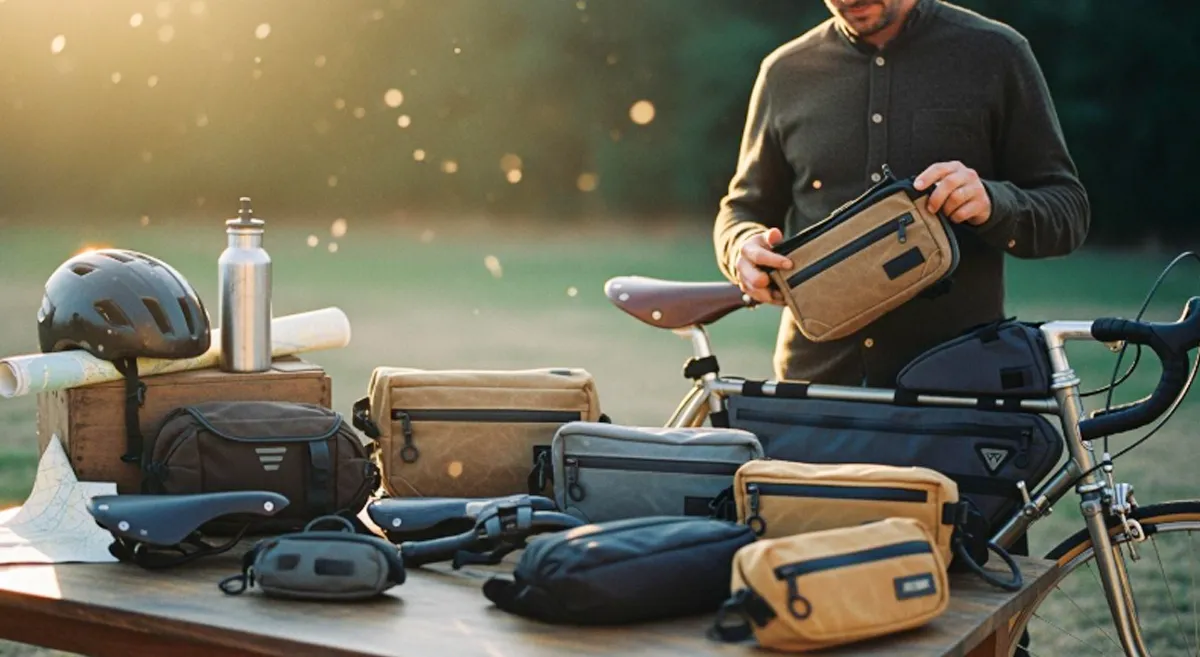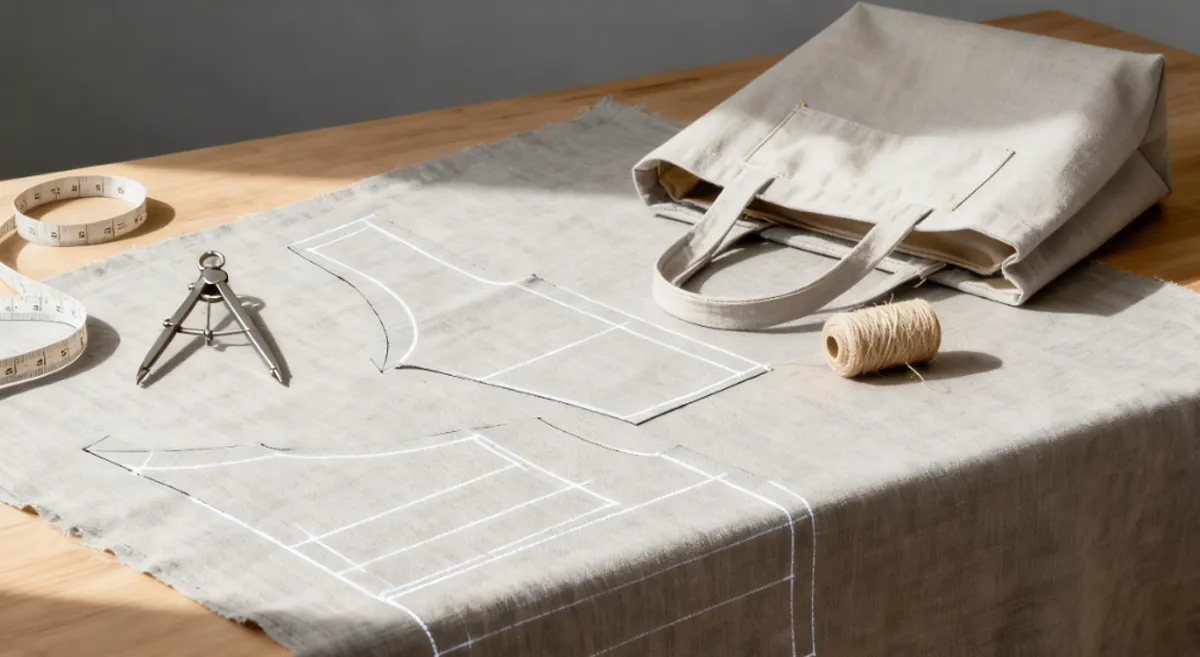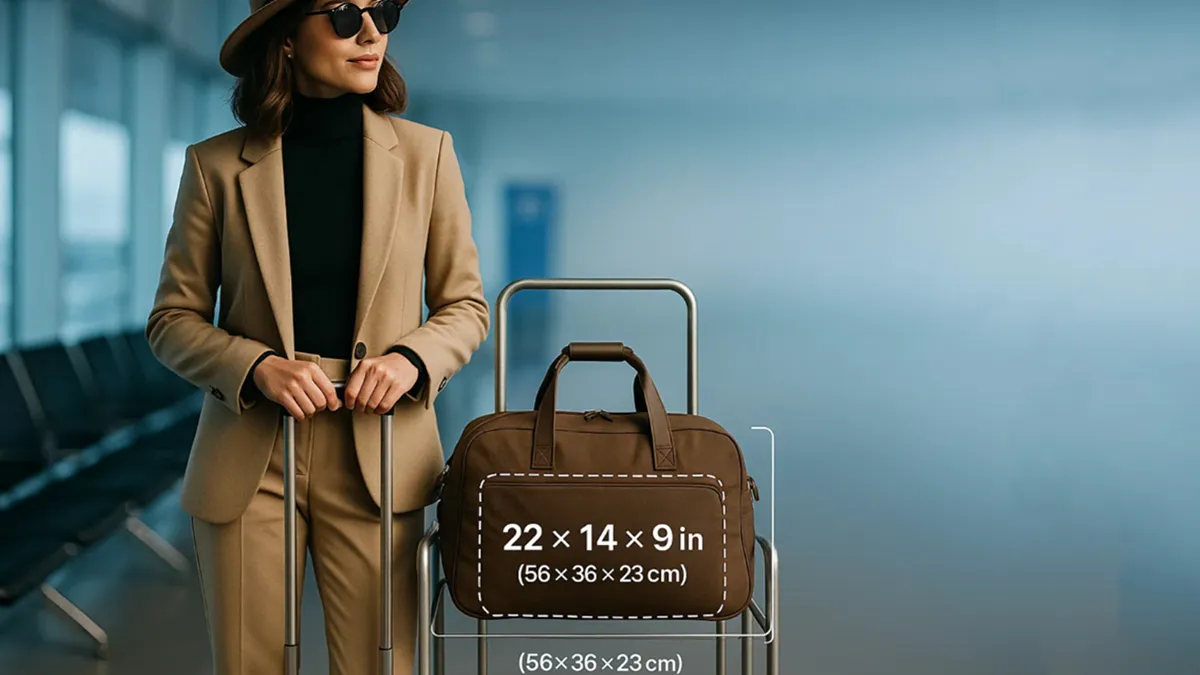
If you want to know what size duffel bag is a carry on, most airlines prefer 22 x 14 x 9 inches, which gives you around 40-45 liters of space. You’ll see these limits with big U.S. airlines like American, United, Delta, and JetBlue. Take a look at this quick table:
| Airline | Carry-On Size (inches) |
|---|---|
| American Airlines | 22 x 14 x 9 |
| United Airlines | 22 x 14 x 9 |
| Delta | 22 x 14 x 9 |
| Southwest Airlines | 24 x 16 x 10 |
| Jetblue | 22 x 14 x 9 |
Soft-sided duffel bag options make it easier for you to squeeze into those overhead bins. Always check your airline’s rules, since some have their own limits. Try to choose a duffel bag that stays light and fits the carry-on size, so your trip feels smooth from start to finish.
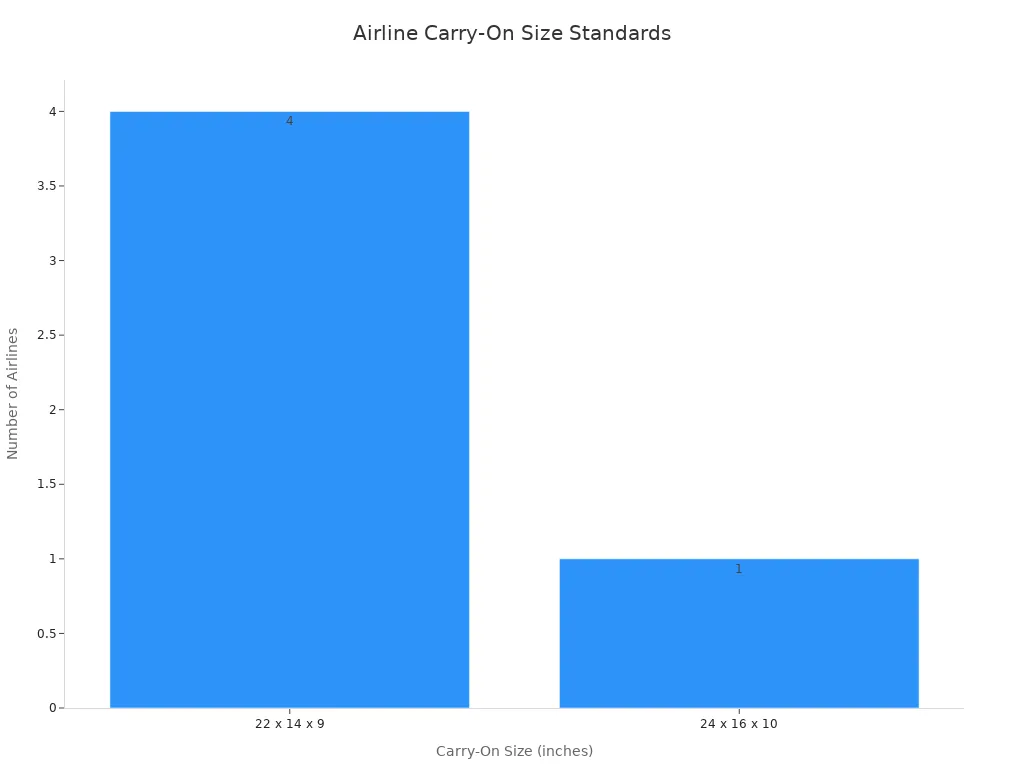
Key Takeaways
- Most U.S. airlines let you bring duffel bags that are up to 22 x 14 x 9 inches.
- A duffel bag should hold 40-45 liters for short trips.
- Soft-sided duffel bags bend and fit well in overhead bins.
- Always look at your airline’s carry-on rules before you pack.
- Rolling clothes helps save space and stops wrinkles in your duffel bag.
- Packing cubes help keep your things neat and easy to find.
- Put important things like passports and chargers in pockets you can reach fast.
- Weigh your duffel bag at home so you do not get surprised at the airport.
What Size Duffel Bag Is a Carry On
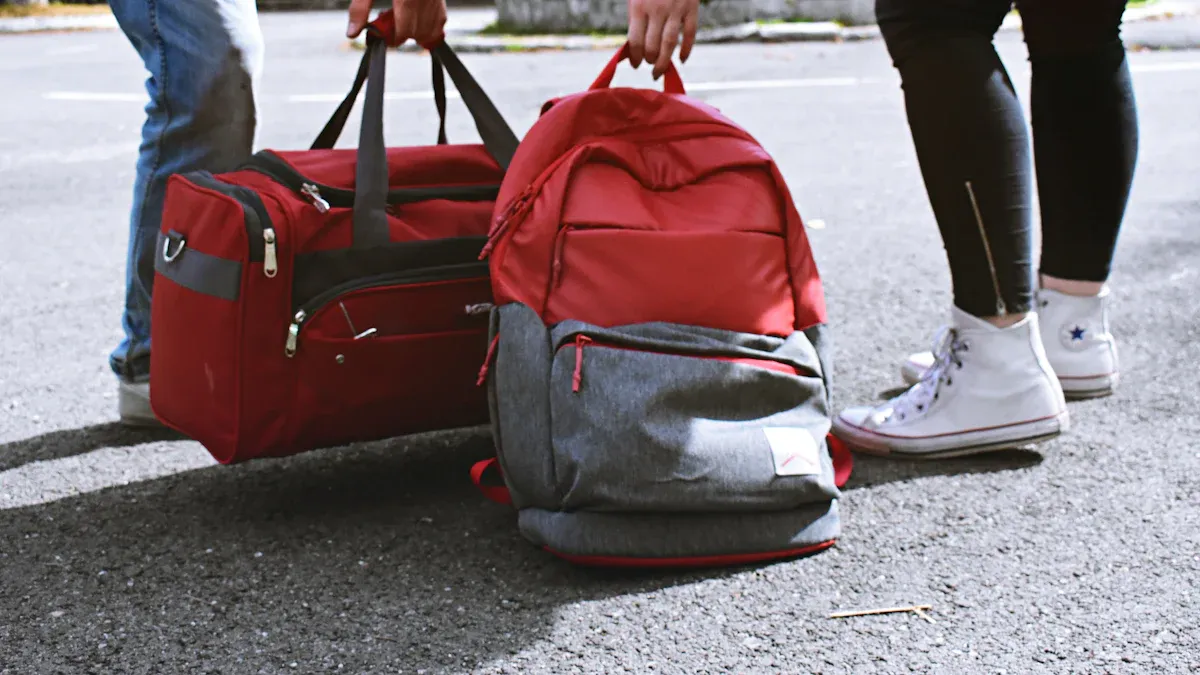
Standard Dimensions
22 x 14 x 9 Inches
When you ask, “what size duffel bag is a carry on,” you want a clear answer. Most airlines stick to the 22 x 14 x 9 inch rule. This size works for almost every major U.S. airline. You can pack your duffel bag and feel confident it will fit in the overhead bin. The 22x14x9 inch parameters include wheels and handles, so measure your bag from end to end. If you travel with international airlines, you might notice the size drops a bit. Many international carriers set their limit closer to 21 inches. Budget airlines like Spirit or Ryanair often have even stricter rules. Always double-check before you fly.
- Most U.S. airlines allow carry-ons up to 22″ x 14″ x 9″.
- International airlines usually set the limit around 21″.
- Budget airlines enforce smaller size restrictions.
40-45 Liter Capacity
Now, let’s talk about how many litres should a carry-on duffel be. The sweet spot is 40-45 liters. This capacity gives you enough room for a weekend trip or a short business visit. You can fit clothes, shoes, and your essentials without overstuffing. If you go bigger, you risk having to check your bag. Smaller duffel bags, under 40 liters, work best for one or two nights away. Rolling duffels can hold much more, but they usually don’t meet the carry-on duffel bag size rules.
- Small carry-on duffel bags range from 40–45 liters.
- Perfect for 1–3-night trips.
Here’s a quick look at how duffel bags compare to other carry-on luggage:
| Carry-On Luggage | Dimensions (inches) | Weight (lbs) | Volume (L) |
|---|---|---|---|
| Option 1 | 22.1 x 14.3 x 9.1 | 10.1 | 36.0 |
| Option 2 | 23.5 x 14.3 x 9.0 | 8.1 | 40.0 |
| Option 3 | 22.0 x 13.0 x 9.0 | 5.2 | 42.2 |
| Option 4 | 22.0 x 15.7 x 10.2 | 8.1 | 40.3 |
| Option 5 | 20.0 x 14.0 x 10.0 | 7.2 | 40.0 |
| Option 6 | 22.0 x 14.0 x 12.0 | 6.5 | 41.2 |
| Option 7 | 23.0 x 15.0 x 10.0 | 6.6 | 41.2 |
| Option 8 | 21.1 x 14.0 x 9.1 | 5.5 | 36.5 |
| Option 9 | 23.0 x 14.1 x 10.0 | 7.3 | 40.5 |
| Option 10 | 20.5 x 14.0 x 9.0 | 6.0 | 42.5 |
| Option 11 | 19.0 x 13.5 x 10.0 | 6.6 | 35.0 |
| Option 12 | 22.0 x 14.8 x 10.0 | 5.7 | 36.0 |
| Option 13 | 19.0 x 13.5 x 9.0 | 6.1 | 34.5 |
| Option 14 | 19.0 x 14.0 x 8.0 | 6.2 | 35.0 |
| Option 15 | 21.1 x 14.6 x 8.5 | 5.4 | 32.5 |
| Option 16 | 19.0 x 13.0 x 6.0 | 5.0 | 24.5 |
Soft-Sided Duffel Bag Flexibility
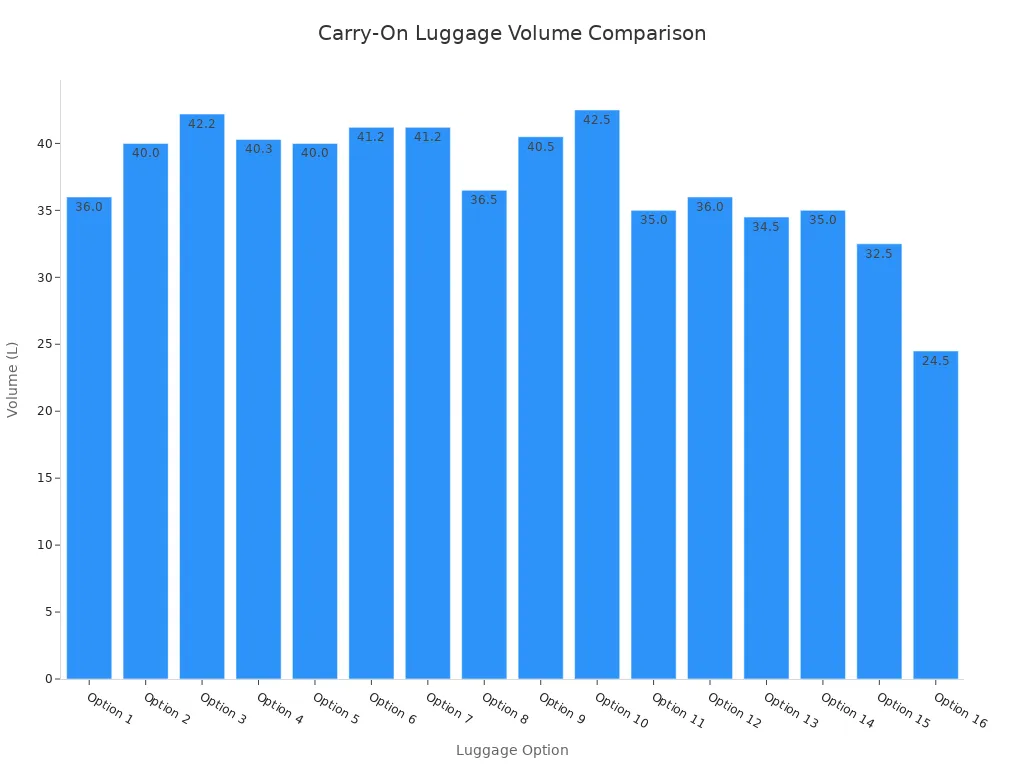
You might wonder why so many travelers pick a duffel bag for their carry-on. Soft-sided duffel bags make packing easier. You can squeeze them into tight spaces, and they flex to fit airline sizers. If you pack smart, your duffel bag will slide right into the overhead bin, even if the flight is crowded. Hard-sided luggage stays rigid, so it can’t adapt if you overpack or if the bin is full.
Tip: Soft-sided duffel bags often come with expansion zippers. If you need a little extra room, just unzip and pack those last-minute items.
Here’s a quick comparison to show you why soft-sided duffel bags win for flexibility:
| Feature | Soft-Sided Duffel Bags | Hard-Sided Luggage |
|---|---|---|
| Weight | Generally lighter | Heavier |
| Flexibility | Can flex and compress | Rigid |
| Space fitting | Fits into tight spaces easily | Limited fitting |
| Expansion | Often features expansion zippers | Typically does not have this feature |
| Compartment design | Single compartment for easier packing | Multiple compartments can complicate access |
You get a lightweight bag that fits almost anywhere. You can pack and unpack quickly, and you won’t struggle with compartments. If you want a stress-free travel experience, a soft-sided duffel bag is your best bet for carry-on.
- Soft-sided duffel bags are lightweight and flexible.
- They fit into tight spaces and airline sizers.
- Expansion zippers give you extra packing room.
- Single compartment design makes packing simple.
So, when you ask what size duffel bag is a carry on, remember to check the dimensions and volume. Stick to the 22x14x9 inch parameters and keep your duffel bag under 45 liters. You’ll breeze through the airport and avoid checked bag fees. Choosing the right carry-on duffel bag size means less stress and more adventure.
Airline Carry-On Requirements
When you pack for a flight, you want to make sure your bag meets all airline carry-on requirements. Every airline sets its own rules, so you can’t assume one size fits all. Let’s break down what you need to know before you head to the airport.
U.S. Airlines
If you fly with major U.S. airlines, you’ll notice that most stick to similar size limits for carry-on bags. The big names—Delta, United, and American—usually allow a maximum size limit of 22 x 14 x 9 inches for carry-on luggage. You might wonder, “Can a duffel bag be considered a carry-on?” The answer is yes, as long as your duffel fits within these size limits. Most airlines do not set a strict weight limit for carry-ons, but you should still be able to lift your bag into the overhead bin by yourself.
Here’s a quick look at the current size and weight rules for some top U.S. airlines:
| Airline | Maximum Size (inches) | Maximum Weight (lbs) | Notes |
|---|---|---|---|
| Delta Air Lines | 22 x 14 x 9 | No general weight limit | Some airports have special weight rules. |
| United Airlines | 22 x 14 x 9 | No maximum weight | Oversized bags may get checked at the gate. |
You can see that the size stays the same, but the weight rules can change depending on where you fly. Always double-check before you pack.
International Airlines
Traveling overseas? International airlines often have different requirements. The size limit for carry-on bags can be smaller, and weight restrictions are usually stricter. Can a duffel bag be considered a carry-on on these flights? Yes, but you must pay close attention to both the size and the weight.
Here’s how some leading international airlines compare:
| Airline | Maximum Size (cm) | Weight Limit (kg) |
|---|---|---|
| British Airways | 56 x 45 x 25 | 23 |
| Lufthansa | 55 x 40 x 23 | 8 |
| Emirates | 55 x 38 x 20 | 7 (Economy), 10 (Premium Economy) |
Notice that the size can be a bit smaller than U.S. airlines, and the weight limits are much lower. If you go over the limit, you may have to check your bag or pay extra fees. Always check the airline carry-on rules for your specific flight.
How to Check Rules
You might ask, “How do I know if my bag meets the requirements?” The best way is to check the airline’s official website before you travel. Airlines update their travel regulations often, so you want the latest information. Here’s a simple checklist to help you stay on track:
- Visit your airline’s official website for the most current carry-on allowances.
- Look for the size and weight requirements for carry-on luggage.
- Make sure your duffel bag fits within the maximum size limit.
- Double-check if your flight has special rules for certain airports or international routes.
Tip: Don’t rely on old information or what worked on your last trip. Airline carry-on requirements can change, and each airline has its own rules.
By following these steps, you’ll avoid surprises at the gate and keep your travel stress-free. Remember, travel regulations and size limits can change, so always stay updated. With the right prep, your duffel bag will fit perfectly as a carry-on, no matter where you fly.
Choosing the Right Duffle Bag Size
Picking the right duffle bag size can make your trip much easier. You want a bag that meets airline size and weight requirements, feels comfortable to carry, and keeps your stuff safe. Let’s look at the features that matter most when you’re searching for the best carry on.
Key Features
Lightweight Materials
You don’t want to lug around a heavy bag before you even pack your clothes. Most duffel bags weigh less than rolling suitcases. That means you can pack more without worrying about going over the airline’s size and weight requirements. Lightweight materials like nylon or polyester help keep your duffel bag easy to carry and simple to stow.
Expandable Compartments
Sometimes you need a little extra space for souvenirs or last-minute items. Many duffel bags come with expansion zippers or flexible sides. These features let you adjust the size of your bag, so you can fit more in without breaking the rules. Just remember, if you expand your duffel bag too much, it might not meet the carry-on luggage size limits.
Durability
Travel can be rough on your gear. You want a duffel bag that stands up to bumps, drops, and rainy weather. Look for strong stitching, water-resistant fabrics, and sturdy zippers. A durable duffel bag keeps your things safe and lasts for many trips.
Tip: Always check the total size of your duffel bag. Most airlines allow carry-ons within 45 linear inches (length + width + height). If your bag fits these dimensions, you’re good to go.
Duffel Bag vs. Other Carry-Ons
You might wonder how a duffel bag stacks up against backpacks and rolling suitcases. Here’s a quick table to help you compare:
| Bag Type | Pros | Cons |
|---|---|---|
| Duffel Bag | Spacious and flexible, Lightweight, Easy to carry | Less secure than hardshell luggage, Can be awkward to carry when heavy, Harder to access one item without disrupting the rest |
| Rolling Suitcase | Simple to navigate, Shells are protective and secure, Enable fast travel | Take up space when not in use, Rough terrain can be tricky, Cheap wheels can break easily |
Duffel bags give you flexibility and space. You can squeeze them into tight spots and slide them under the seat if you don’t overpack. Rolling suitcases offer more protection but weigh more and take up extra room. Backpacks work well for hands-free travel but may not hold as much as a duffel bag.
Personal Item vs. Carry-On
Airlines set different rules for personal items and carry-ons. A personal item usually has a max size of 18 x 14 x 8 inches and must fit under the seat in front of you. A carry-on can be bigger, up to 22 x 14 x 9 inches, and goes in the overhead bin. If your duffel bag is small, it might count as a personal item. If it’s larger, it becomes your main carry-on option.
- Always check your airline’s size and weight requirements before you pack.
- A smaller duffel bag lets you bring another bag as your carry-on luggage.
- If you need more space, pick a duffel bag that meets the right duffle bag size for carry-on.
Choosing the right duffle bag size means you travel lighter, pack smarter, and avoid extra fees. You get the best carry on for your needs and breeze through the airport with confidence.
Packing a Duffel Bag as a Carry-On
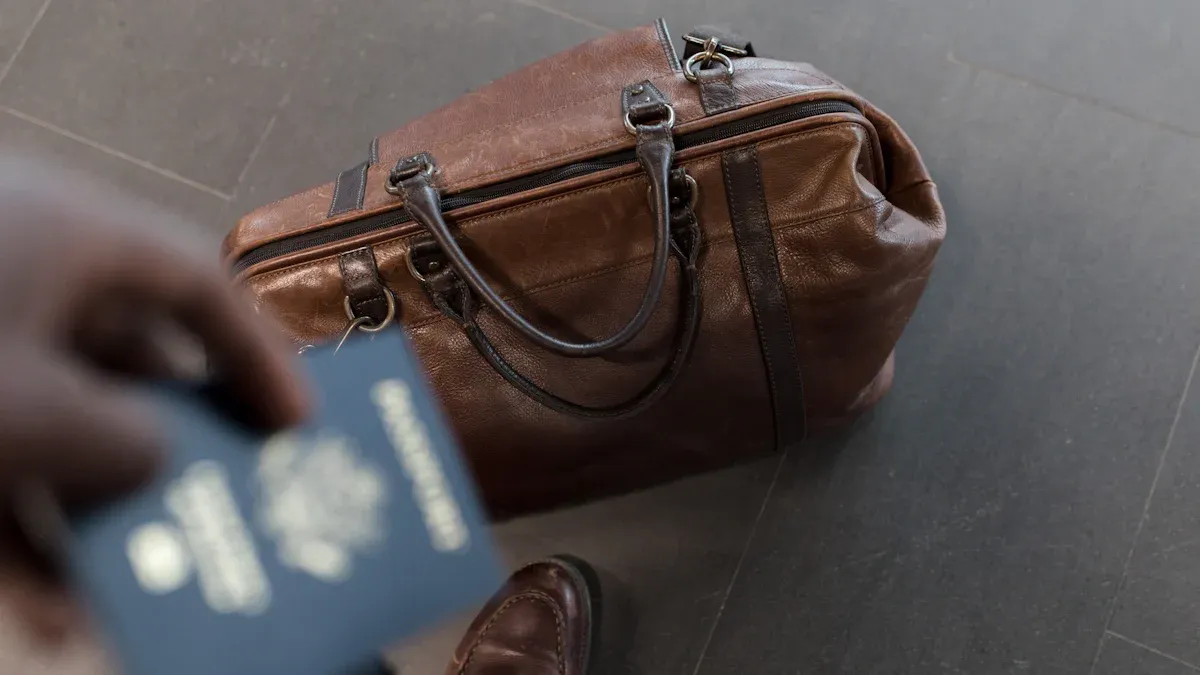
Packing your duffel bag for a flight can feel like a puzzle, but you can fit everything you need with the right tricks. Let’s walk through some easy ways to save space, stay organized, and keep your bag within the right size and weight for carry-on luggage.
Space-Saving Tips
Rolling Clothes
Rolling your clothes is a game changer. When you roll instead of fold, you squeeze out extra air and make your clothes take up less space. You also cut down on wrinkles, so your shirts and pants look fresh when you arrive. Try rolling t-shirts, jeans, and even socks. You’ll be surprised how much more you can fit in your duffel bag.
Packing Cubes
Packing cubes help you keep things tidy and organized. They don’t always save more space than rolling clothes tightly, but they do beat folding clothes into piles. If you use compression cubes, you can cinch down bulky items like sweaters and jackets. Packing cubes also make it easy to grab what you need without digging through your whole bag.
Here are a few more space-saving ideas:
- Stuff socks and small items inside your shoes.
- Use side pockets for things like chargers or snacks.
- Bring a toiletry bag with travel-size bottles.
- Pack a laundry bag to keep dirty clothes separate.
Tip: Make a packing list before you start. This helps you bring only what you need and avoid overpacking.
Organizing Essentials
A well-organized duffel bag makes travel less stressful. Start by putting heavier items, like shoes, at the bottom. This keeps your bag balanced and easier to carry. Place important things—like your passport, medications, or phone charger—in side pockets or on top for quick access. Packing cubes can help you sort clothes by type, so you always know where to find your socks or underwear.
Here’s a simple table to help you organize:
| Item Type | Where to Pack |
|---|---|
| Shoes | Bottom of main compartment |
| Clothes | Rolled or in packing cubes |
| Toiletries | Small toiletry bag, side pocket |
| Essentials | Easy-access pocket |
| Dirty Laundry | Separate laundry bag |
Note: Distribute weight evenly to avoid straining your shoulder or back.
Weight Management
You want your duffel bag to stay light enough to lift into the overhead bin. Most airlines don’t set a strict weight limit for carry-on bags, but international flights often do. Weigh your packed bag at home to make sure you’re under the limit. If your bag feels heavy, take out non-essentials or wear your bulkiest clothes on the plane.
- Keep your bag within the allowed size and weight.
- Only pack what you’ll actually use.
- Place heavier items at the bottom for better balance.
Packing your duffel bag the smart way means you’ll breeze through the airport and enjoy your trip without stress. With these tips, you can make the most of your carry-on and travel with confidence.
Duffel Bag as a Carry-On: Restrictions
Weight Limits
When you use a duffel bag as a carry-on, you need to watch the weight. Airlines set different weight limits for carry-on duffel bags, and these can change depending on where you fly. Most major airlines let you bring a bag that weighs between 15 and 22 pounds (7 to 10 kilograms). Some airlines have higher limits, while others do not set a maximum weight at all. Here’s a quick look at what you might see:
- American Airlines: Up to 40 pounds
- Frontier Airlines: Up to 35 pounds
- Hawaiian Airlines: Up to 25 pounds
- Spirit Airlines: Up to 40 pounds
- United Airlines: Up to 50 pounds
- Delta, JetBlue, and Southwest: No maximum weight for carry-ons
You should always check your airline’s website before you pack. If you go over the weight limit for carry-on duffel bags, you might have to check your bag or pay extra fees. Keeping your duffel bag light makes it easier to lift into the overhead bin and helps you avoid surprises at the gate.
TSA Rules
The TSA has clear rules for what you can pack in your duffel bag as a carry-on. You can bring a quart-sized bag of liquids, aerosols, gels, creams, and pastes. Each container must be 3.4 ounces (100 milliliters) or less. If you have anything larger, you need to put it in your checked bag. The tsa guidelines for carry-on bags also say you can only bring one carry-on item and one personal item. Your duffel bag must fit in the overhead bin or under the seat.
Here’s a quick list of tsa guidelines for carry-on bags:
- Only one carry-on and one personal item allowed
- Liquids must be in containers of 3.4 ounces or less
- All liquids must fit in a single quart-sized bag
- Items may get extra screening if they trigger alarms
- TSA may deny items that look tampered with or unsafe
You should always follow tsa rules to avoid delays. Even if something is allowed, TSA agents might ask you to remove it for extra screening. If you want a smooth trip, pack your duffel bag with these rules in mind.
Overhead Bin Space
Overhead bin space can fill up fast, especially on busy flights. When you use a duffel bag as a carry-on, you have an advantage. The soft sides let you squeeze your bag into tight spots, even if the bins look full. Still, you need to follow size restrictions for carry-on bags. If your duffel bag is too big, the crew might ask you to check it at the gate.
Here are some tips to make sure your duffel bag fits:
- Stick to the standard carry-on size: 22 x 14 x 9 inches
- Don’t overpack or use expansion zippers if the bin space is tight
- Place your bag in the bin wheels or handles first for a better fit
If you board late, you might find the bins full. In that case, the airline may check your bag for free. To avoid this, try to board early and keep your duffel bag within the size restrictions.
Using a duffel bag as a carry-on gives you flexibility, but you still need to follow the rules. Watch the weight limit for carry-on duffel bags, follow tsa rules, and make sure your bag fits in the overhead bin. This way, you travel with less stress and more confidence.
Common Mistakes
When you use a duffel bag as a carry-on, it’s easy to make a few mistakes that can turn your smooth trip into a hassle. Let’s walk through the most common slip-ups travelers make, so you can avoid them and breeze through the airport with confidence.
- Ignoring Airline Size Limits
You might think your duffel bag looks small enough, but every airline has its own rules for carry-on duffel bag size. Some airlines stick to the classic 22 x 14 x 9 inches, while others go even smaller, especially on international flights. If you skip checking the exact size requirements, you could end up at the gate with a bag that’s just a little too big. That means you might have to check your bag last minute, pay extra fees, or even risk missing your flight. Always double-check your airline’s website before you pack. It only takes a minute, and it saves you a lot of stress. - Overpacking Your Bag
It’s tempting to stuff your duffel bag with everything you think you’ll need. You roll your clothes, use every pocket, and squeeze in that extra pair of shoes. But overpacking can make your bag bulge past the allowed size. It also makes your bag heavy and hard to lift into the overhead bin. If you’re going on a longer trip, consider using a checked bag for the bulk of your stuff. Keep your carry-on duffel bag light and easy to manage. You’ll thank yourself when you’re not struggling down the aisle or fighting with the bin. - Bringing Forbidden Items
TSA rules for duffel bags are strict. You can’t bring certain things in your carry-on, like large bottles of shampoo, sharp objects, or some types of batteries. If you forget and pack a forbidden item, you’ll get stopped at security. That means delays, extra screening, and sometimes having to throw away your stuff. Before you zip up your bag, take a quick look at the TSA’s list of prohibited items. It’s a simple step that keeps your trip on track. - Placing Valuables in Checked Bags
Sometimes, you might feel tempted to toss your laptop, camera, or medicine into your checked luggage to lighten your carry-on. This is risky. Checked bags can get lost, delayed, or damaged. Always keep your valuables, electronics, and important documents in your duffel bag as a carry-on. That way, you have what you need right by your side.
Tip: Make a quick checklist before you pack. Double-check your duffel bag size, keep your packing light, follow TSA rules, and always keep your valuables close. You’ll travel smarter and avoid the most common mistakes.
Traveling with a duffel bag as a carry-on can be easy and stress-free if you watch out for these pitfalls. Stay aware, pack smart, and you’ll enjoy your journey from start to finish.
Final Checklist for Your Duffel Bag
Essentials
Before you zip up your duffel bag, make sure you have all the must-haves for your trip. You want to feel ready for anything, so let’s run through a quick list:
- Choose the Right Size: Pick a bag that fits airline rules, usually between 40 and 50 liters.
- Go for Durable Materials: Nylon, polyester, or synthetic leather work best. Water-resistant fabrics help keep your stuff dry.
- Comfortable Straps and Handles: Adjustable straps and padded handles make carrying your bag much easier.
- Smart Compartments: Use the main compartment for clothes and toiletries. Side pockets are perfect for travel documents and small items.
- Laundry Bag: Toss in a lightweight mesh bag for dirty clothes. This keeps everything else fresh.
- Toiletry Bag: Pack travel-size liquids in a clear bag to breeze through security.
- Easy-Access Pockets: Store your passport and tickets in outside pockets for quick grabs.
Tip: Double-check your essentials before you leave. It’s easy to forget something small but important!
Size and Weight Check
You don’t want any surprises at the airport. Checking your duffel bag’s size and weight before you go saves time and stress. Here’s how you can do it:
- Measure your bag’s length, width, and height. Most airlines want a combined size under 45 inches for a carry-on.
- Weigh your packed bag at home. Many airlines allow up to 22 pounds, but some international flights have lower limits.
- Look up your airline’s baggage policy online. Rules can change, so always check before you fly.
- If your bag feels heavy, take out non-essentials or wear your bulkiest clothes on the plane.
| Step | What to Do |
|---|---|
| Measure | Check length, width, and height |
| Weigh | Use a home scale for your packed bag |
| Review Airline Rules | Visit your airline’s website for latest limits |
| Adjust | Remove items if you’re over the limit |
Note: Staying within the size and weight rules helps you avoid extra fees and keeps your trip smooth.
Travel Day Tips
Travel day can get hectic, but a little prep goes a long way. Here are some tips to make your journey easier:
- Use a duffel bag with both a padded shoulder strap and sturdy handles. This makes it easy to carry, even in crowded airports.
- Pick a bag with lots of pockets. You’ll find your passport, phone, or snacks fast—no digging required.
- Choose weatherproof materials. Rain or spills won’t ruin your clothes or electronics.
- Check for extra features like wheels or convertible straps. These can make moving through the airport a breeze.
- Keep your bag close and never leave it unattended.
Remember: A well-packed duffel bag means less stress and more time to enjoy your adventure!
You now know that most airlines set the standard duffel bag size for carry-on luggage at 22 x 14 x 9 inches. Always check your airline’s rules before you pack, since limits can change. Here’s a quick recap to help you travel smart:
- Choose a duffel bag with sturdy construction and multiple compartments.
- Roll your clothes and use packing cubes to save space.
- Keep essentials in easy-to-reach pockets.
- Make sure your carry-on fits both your needs and airline requirements.
Want a custom duffel bag for your next trip? We’re manufacturers who support OEM/ODM customization—let’s make your travel easier!
FAQ
What size duffel bag can you use as a carry-on?
You can use a duffel bag that measures up to 22 x 14 x 9 inches for most airlines. This size fits in overhead bins and meets standard carry-on requirements. Always check your airline’s website for the latest rules before you pack your travel duffel.
Can you use a duffel bag as a personal item?
Yes, you can use a small duffel bag as a personal item if it fits under the seat in front of you. Most airlines allow personal items up to 18 x 14 x 8 inches. If your duffel is larger, it counts as your main carry-on.
How do you measure a duffel bag for airline travel?
Grab a tape measure and check the length, width, and height of your packed duffel, including handles and wheels. Add those numbers together. If the total is under 45 inches, you’re good for most airlines. Always measure after packing to avoid surprises.
What’s the best way to pack a duffel bag for a flight?
Roll your clothes to save space, use packing cubes for organization, and put heavier items at the bottom. Keep essentials like your passport and charger in side pockets. Packing smart helps you fit more and keeps your duffel bag easy to carry.
Are there weight limits for duffel bag carry-ons?
Most U.S. airlines don’t set strict weight limits for carry-on duffel bags, but international airlines often do. You’ll usually see limits between 15 and 22 pounds. Weigh your bag at home and check your airline’s rules to avoid extra fees or gate checks.
Can you bring liquids in a duffel bag carry-on?
You can bring liquids in your duffel bag, but each container must be 3.4 ounces or less. All liquids need to fit in a single quart-sized clear bag. TSA rules apply to all carry-ons, so pack your toiletries carefully to breeze through security.
What happens if your duffel bag is too big for carry-on?
If your duffel bag is too big, the airline may ask you to check it at the gate. You could pay extra fees or wait for your bag at baggage claim. To avoid this, always measure your bag and stick to the airline’s carry-on size limits.
Are soft-sided duffel bags better for carry-on travel?
Soft-sided duffel bags give you more flexibility. You can squeeze them into tight spaces and overhead bins. They’re lightweight and easy to carry. If you want stress-free travel, a soft-sided duffel bag is a great choice for your next flight.


